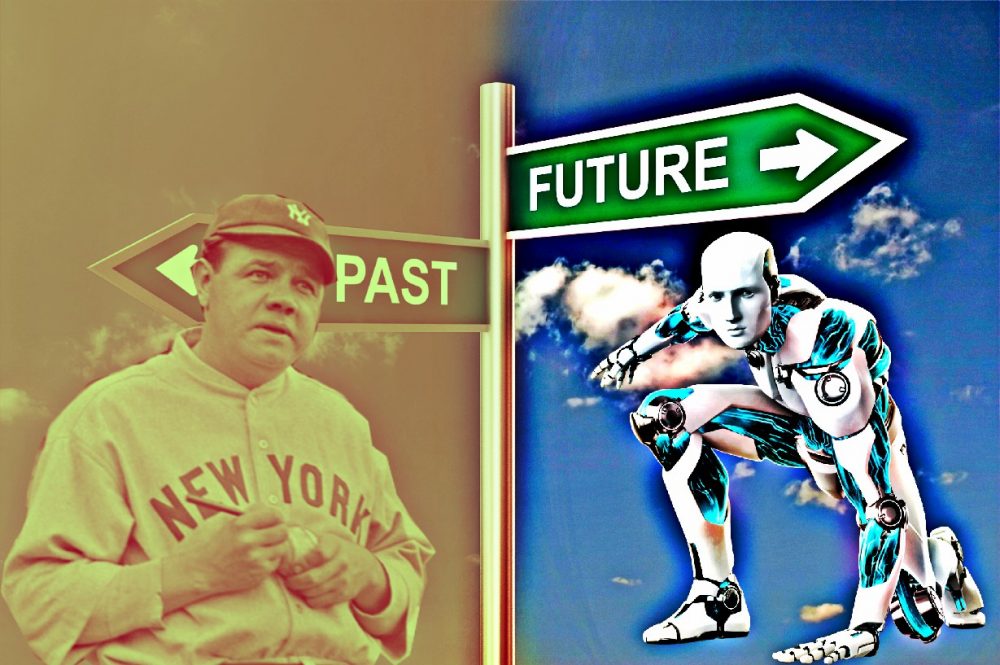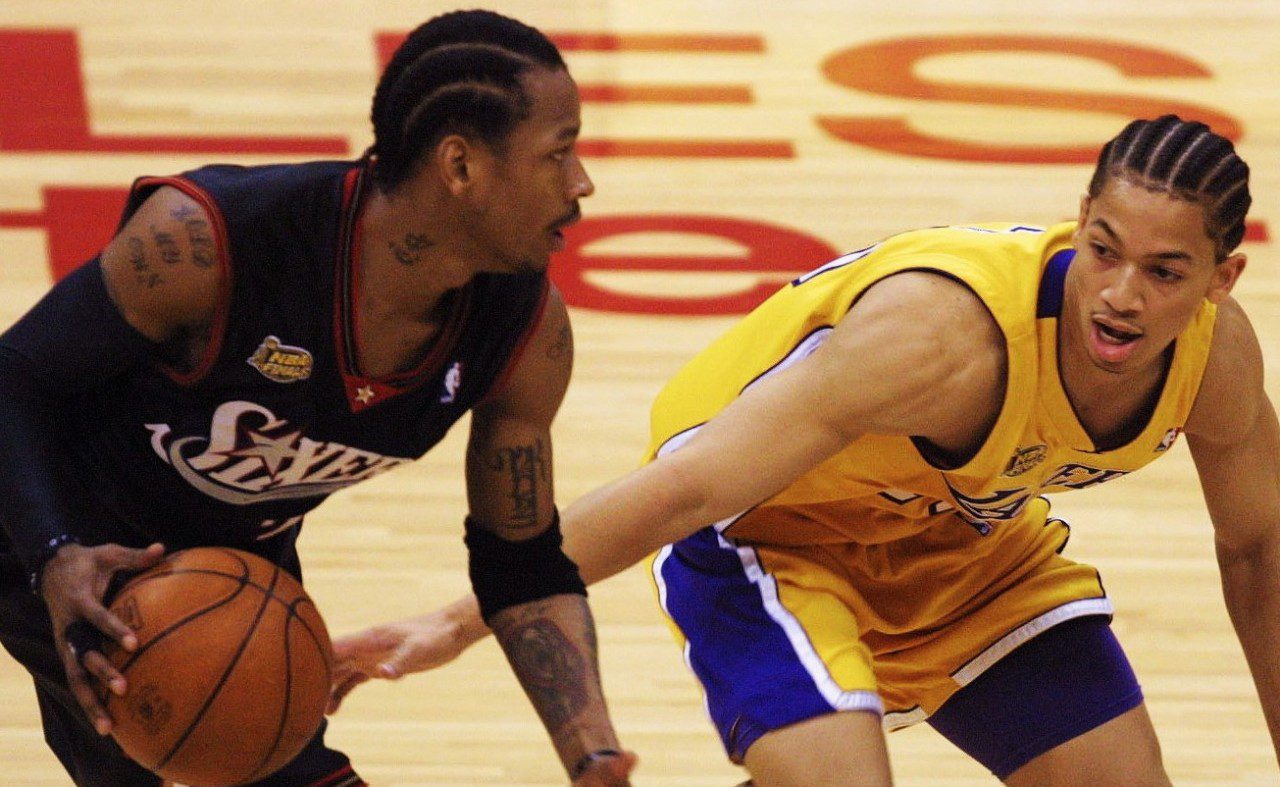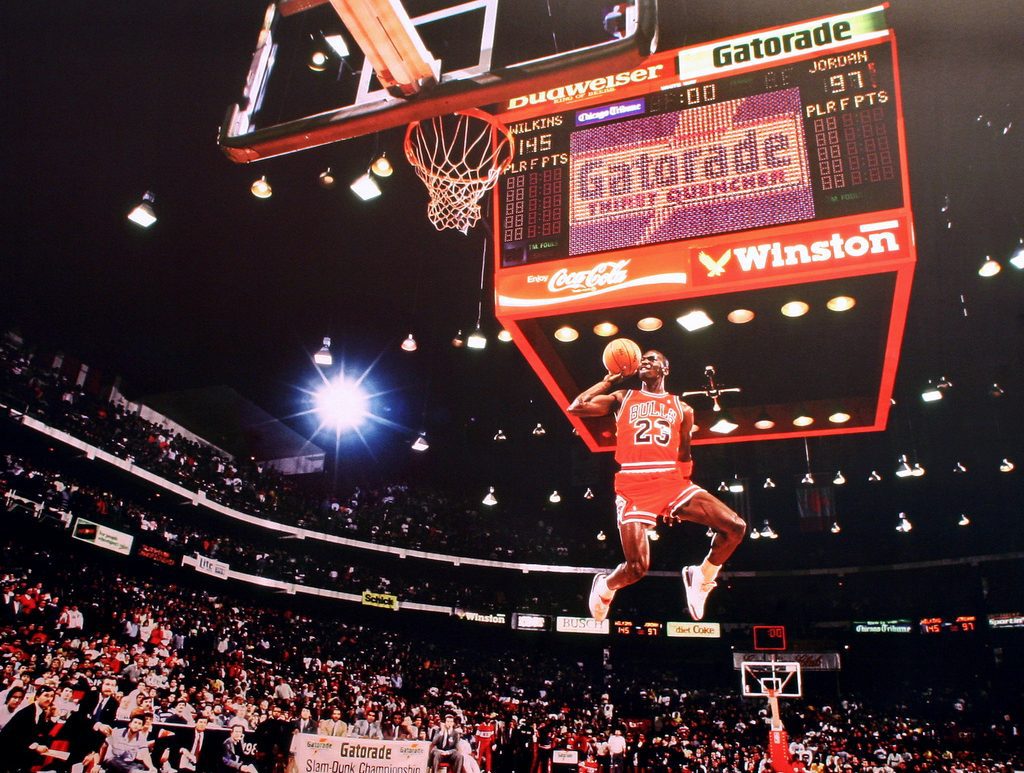Collin – “Would Babe Ruth be able to make an MLB team today?”
I would like to offer two sincere congratulations to my friend Collin Stucko. First, his Villanova Wildcats are one win away from a National Title, and as a consolation prize, if Nova doesn’t win Collin will have won my 8th annual Yahoo! Sports Tourney Pick’em challenge. Second, this question that you sent in has made me care more about baseball than I have since I jumped on the bandwagon of that lovable Florida Marlins squad that won the 2003 World Series. I truly didn’t think that it was possible that I could spend the better part of the month of March thinking about baseball, at least not unless the MLB adopted the rule changes Dalton Baggett and I suggested back in 2016. Anyway, for some reason, this question piqued my interest in a major way.
I would assume that there’s at least a handful of older readers here, perhaps even some who are New York Yankees fans, who will surely scoff at the suggestion that Babe Ruth couldn’t hang against today’s talent. Maybe they’ll be so disgusted that I would even entertain this question that they’ll spend the next 90 seconds trying to figure out how to close this window. If you’re willing to stick around, just hear me out, O.K.?
First things first, we should all be able to agree that athletes (and human beings in general) have evolved over time, correct? I’m not breaking any news by saying this. Any rational person with functioning eyeballs can watch this three minute and 47 second clip of George Mikan — a Basketball Hall of Famer and a member of the NBA’s 50th Anniversary All-Time team — and agree that Mikan, or any inferior player from Mikan’s era would never stand a chance of playing in the NBA today.
Now look, I’m not trying to chip away at my base of readers, but if you’re disagreeing with the assertion that I just made after watching that video, the “X” in the top right hand corner of your screen is how you exit this window. We won’t be able to come to common ground on anything, and when I start talking about Robots later on in this mailbag you’re probably going to end up very upset.
Back to Babe Ruth: Here’s the thing that works in the Sultan of Swat’s favor … we’ve seen out of shape players, or at least players who aren’t ridiculous physical specimens, thrive in modern MLB, so that eliminates the argument that the Babe (6’2″, 215 lbs.) was either too small (clearly he wasn’t) or wasn’t in proper cardiovascular shape to play professionally today. This isn’t a George Mikan situation. What I instead needed to look at to make a judgment are factors that are mostly circumstantial, and these factors would have to point us in one of two directions — either Ruth was handicapped by playing when he did, or that Ruth benefited from playing when he did.
The truth of the situation is that more factors that worked in The Bambino’s favor than those that took away from his opportunity to dominate. Sure, he didn’t have the luxury of modern travel, medical advancements, or training techniques, but if Babe were wired the same way mentally as he was in the 20’s, there’s no guarantee this newfound knowledge would lead to him giving up the girls, food or the booze. And plus, assuming that Babe would change certain habits goes against the entire point of the Time Machine Game. If we’re questioning whether Babe Ruth would be able to make an MLB Team today, we must assume that when he was transported in the Time Machine nothing about him would fundamentally change.
And that means if we transported The Colossus of Clout nearly 100 years into the present day, he wouldn’t be facing Pitchers who were pacing themselves knowing that they’d regularly be required to pitch a complete game. Ruth also wouldn’t be facing Pitchers who were mostly topping out in the high 80’s on their fastballs (to be fair, I couldn’t find definitive data on pitch speed, but most websites estimated that only a handful of Pitchers threw 90+ miles per hour back in Babe’s heyday). Additionally, Babe would be facing a level of competition that far exceeded what he faced in the all-white MLB of the 1910’s and 1920’s. Nearly every Baseball Historian I came across in this research agreed that Babe — and every other white baseball player of that time — were beneficiaries of segregation. And let’s not forget, that means there certainly weren’t any Latin American players (who made up 29% of the MLB in 2015) raising the quality of play back then either.
The contrarian to my position would surely say, “Well just look at the power Babe Ruth had. That would carry over to the league today,” and I wouldn’t have much defense for that. The legendary tales of Babe’s power sound more like folk stories than they do real life accounts of what happened in the past, though there’s no reason not to believe them. My one counter would be this: Babe had power, but the huge Home Run numbers can be explained beyond that.
In 1920, a rule change was made in pro baseball that stated “balls hit over the fence in fair territory but landing foul were fair, and hence home runs rather than foul balls.” This is significant for two reasons:
1. Babe Ruth’s home run total increased from 29 to 54 from the 1919 to 1920 season. And yes, I realize that every player had this luxury back then, not just Babe Ruth, and yes, I realize this rule still holds today. However …
2. Starting in 1920, after Babe Ruth was traded to the New York Yankees, he was playing half of his games each season at the Polo Grounds. The old Polo Grounds had a notoriously deep Center Field (483 feet), but the shortest distance to clear the fence in Right Field was only 258 feet, which is far shorter than any field today. This is significant because Babe, a lefty hitter, would pull balls right often, and since he had to only clear 258 feet — and because new rule changes allowed his hooking balls that started fair and ended up in foul territory to be deemed Home Runs — Babe hit 113 homers in the two seasons following the rule changes.
In 1923 the Yankees moved from the Polo Grounds to Yankee Stadium, and Babe had to contend with a Right Field wall that was only 295 feet. For what it’s worth, a 13 year old blasted a 375 foot homer in the Little League World Series last August. The greatest power hitter ever would have scoffed at a 295 foot wall.
Babe Ruth was clearly light years ahead of his time. There’s a noticeable difference between him and his peers. His impact on the popularity of Baseball was Jordanesque — or rather, Jordan’s impact on the popularity of Basketball was Ruthian. The Yankees are The Yankees because of Babe Ruth, and baseball survived the Dead Ball Era because Babe Ruth hit the sport out of it. He’s an American Icon, and that distinction is well-deserved … but suggesting that he’d have remotely the same sort of career in the 21st Century as he did in the 20th Century means your just ignoring facts, common sense, and human evolution.
Shelly – “Will we see another sport gain mainstream popularity in America in our lifetime? (This could be a sport that already exists that isn’t popular or a totally new sport)”
Ya know, I’m actually really happy that this question was sent my way because about a month ago I was pondering this very concept. I was listening to a 30 for 30 Podcast No Rules: The Birth of UFC and I was reminded that the Ultimate Fighting Championship, or I suppose more specifically Mixed Martial Arts (MMA), is the newest sport to gain mainstream attention, and it happened in my lifetime. The first UFC pay-per-view was held in 1993, and by 2008 nearly 100 pay-per-views were in the books and the sport was officially on the map.
In order to answer this question, I figured it was important to understand how UFC was able to make such a startling rise in only fifteen years, and in order to understand why UFC skyrocketed to mainstream relevance, it’s necessary to have at least a general understanding of Malcolm Gladwell’s Tipping Point Theory.
Gladwell’s Tipping Point Theory suggests that “Ideas and products and messages and behaviors spread like viruses do.” Gladwell goes on to explain that there are three rules of epidemics, and while I won’t explain what all three rules are, I believe one of them applies here. The second rule is called “The Stickiness Factor,” which has to do with what about the whether or not the message of a product is memorable. Gladwell states “there is always a simple way to package information that, under the right circumstances, can make it irresistible.” For the UFC, there is no clearer example of a Tipping Point or the Stickiness Factor at work than The Ultimate Fighter Season 1 finale.
I mean, the video itself is titled “TUF finale launches UFC into mainstream America,” so you know I’m not bullshitting you. The Ultimate Fighter was a Mixed Martial Arts competition program on Spike TV that focused on sixteen fighters who were competing to earn a UFC contract. The Season 1 finale aired on April 9th, 2005, and the broadcast was both simple and captivating. As boxing continued to trend towards becoming obsolete in the United States, the UFC was the newer, edgier, and more exciting alternative that fight fans didn’t know they wanted until they saw it for the first time. When Stephan Bonnar and Forrest Griffin slugged it out for fifteen grueling minutes with a contract on the line, UFC officially became the first sport that both materialized and completely blew up in my lifetime. On a personal note, I was hooked that night. Nearly 13 years later I still remember watching it with my Dad and Uncle and cousins. My guess would be that this event — and really, just the Bonnar/Griffin fight in particular — created more UFC fans than any other night in the history of the sport. It was the ultimate Tipping Point.
Back to the original question: It’s impossible to accurately forecast what a “new sport” might look like, unless we were to imagine that an evolutionary/safer version of football will catch on if/when the version of football we’re used to goes away. This means I’m left to look at sports that are already established and in the public eye to some degree, but still have room for rapid upward mobility within the sports world, and in order upset the balance of the current pecking order, it’s important to consider what sports have the chance to have their own Tipping Point. Where things stand right now, I see two plausible options:
Curling – Curling has been the gem of the Winter Games for years, and by 2014 everyone had agreed on this. The United States men’s team winning the Gold Medal was the most noteworthy outcome of the 2018 Winter Olympics; it was arguably the best Winter Olympic moment for the United States since the men’s hockey team almost defeated Canada in the Gold Medal Hockey game in 2010. What happens to Curling in this country by the time the 2022 Winter Olympics roll around really interests me. In the U.S. Curling is still a regional sport that’s mostly confined to the Midwest and New England, but if mainstream interest increases in these next four years, and if the United States is again in contention for Gold in 2022, the momentum could begin to build for Curling to be something more than a niche sport that every viewer thinks they could easily master. 2018 will have been the Tipping Point.
Handball – In my opinion, this is more likely. In fact, if someone were to ask me to make a handful of predictions about what’s to come in the world of sports by the halfway point of the 21st Century, the very first proclamation that I’d make is that Handball will become so popular that when we will no longer be able to talk about “the four major professional sports leagues” in the United States, because a professional Handball league will have forced it’s way into equal standing with both Baseball and Hockey by that time.
It’s easy to track how this would work and what the Tipping Point would be. We’re ten years away from the 2028 Summer Olympics in Los Angeles, and the one Summer Olympic event that the U.S. should kick ass at that we don’t kick ass at is Handball. My guess is by 2024 the United States Men’s Handball team will be ready to contend for the Gold Medal, and in 2028 they’ll win their first one while competing on American soil. The members of that team will become icons (to the degree that a roster of American Handball players can become icons) who are remembered for being pioneers of this emerging sport. From there, thousands more middle schools and high schools will start to teach Handball as a Physical Education unit. Not long after that schools will have Handball teams that are playing for sectional, regional and state titles. By 2035, International Handball Federation World Championship will be broadcast on a major platform all over the world. Five years from then, the National Handball Association will have formed in the United States and have its own very lucrative broadcast deal.
Twelve years. That’s all it took for the UFC to go from 86,000 viewers for UFC 1 in 1993 to over 2 million for The Ultimate Fighter finale in 2005. Twelve years after that, a UFC superstar competed in one of the most hyped boxing fights ever, and the company had already held their 200th pay-per-view. Twelve years is all it will take for Handball. You watch.
Perry – “How concerned are you about robots taking over the world in our lifetime?”
I certainly hope this isn’t the case, because we wouldn’t get to see if my Handball prediction comes to fruition, but I do have fears that by the end of the 21st Century (and I definitely won’t be around then, so oh well) humanity will be overtaken by robots. I will say though, I do have a greater technological fear than this. I suppose that what worries me would only make it easier for a hypothetical Robot takeover, but I truthfully believe I’ll be long gone before the Robots have a chance to take me out. What worries me is that there are two very specific sort of technological revolutions going on, and it seems like people are only interested in the one that isn’t an overt threat to the safety of humanity.
I seriously doubt that anyone has come here to read my attempt at explaining why I’m afraid of Fake News — and I don’t mean the sourced and factual “Fake News” that President Donny whines about because it isn’t a Fox News piece. I’m talking about the sort of fake news that is a blatant attempt to provide misinformation and pollute the masses through means of technological underhandedness. I’m talking about audio and video manipulation, deepfakes, polity simulation, and the eventual “reality apathy” that would result.
(If you don’t have any clue what any of that previous paragraph means, I suggest you read this BuzzFeed piece that was published in February. Don’t even do it for me. Do it for your own good.)
Eventually, everyone will lose faith in however it is that they absorb news and begin to distrust humanity as a whole (unfortunately, this is happening already). Rather than make strides to regain this trust, people will instead immerse themselves in different worlds … virtual worlds. They’ll spend more time living in a world that exists outside of their own reality and inside of VR that they lose track of their own identity and responsibilities. On top of all of that, there is going to continue to be more TV available to be streamed, more music to be listened to, more video games to be played, more apps to waste time scrolling through.
This sort of stuff will ruin us long before Robots ever get a chance to, but when it’s time for the Robots to take over, humans won’t even notice that it’s happening. If you don’t think it’s going to happen, it means that you’re ignoring facts, common sense, and technological evolution.

















